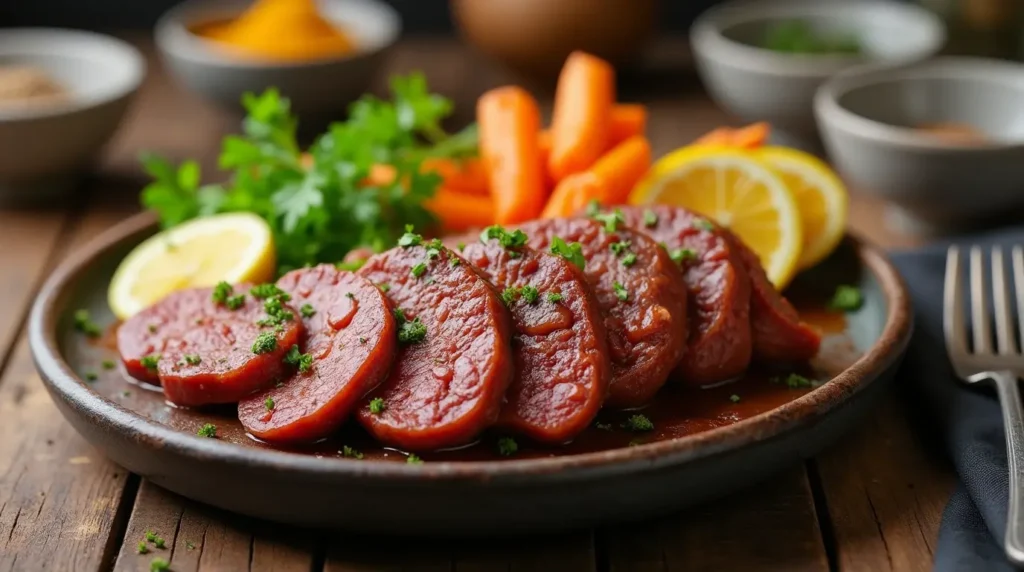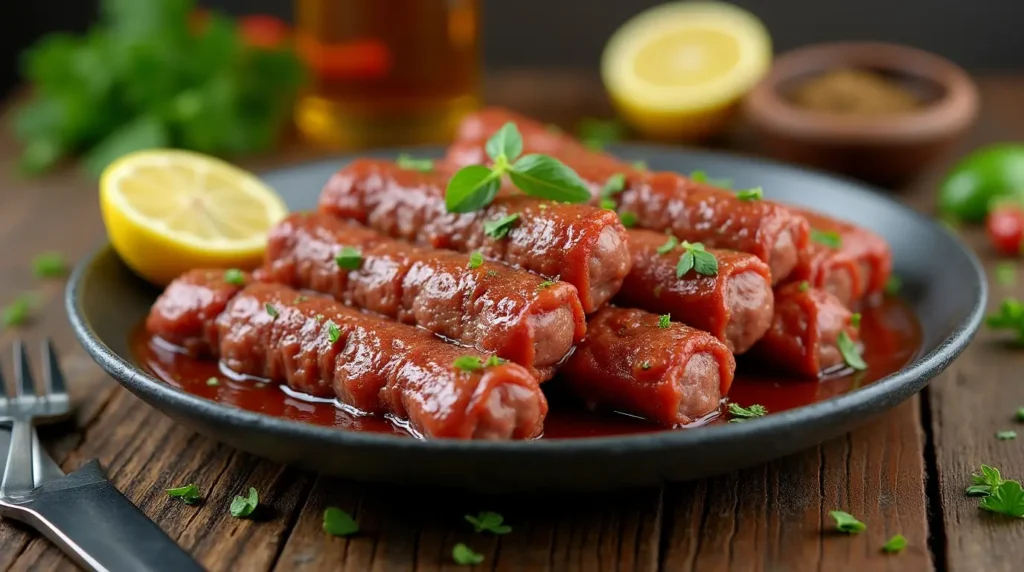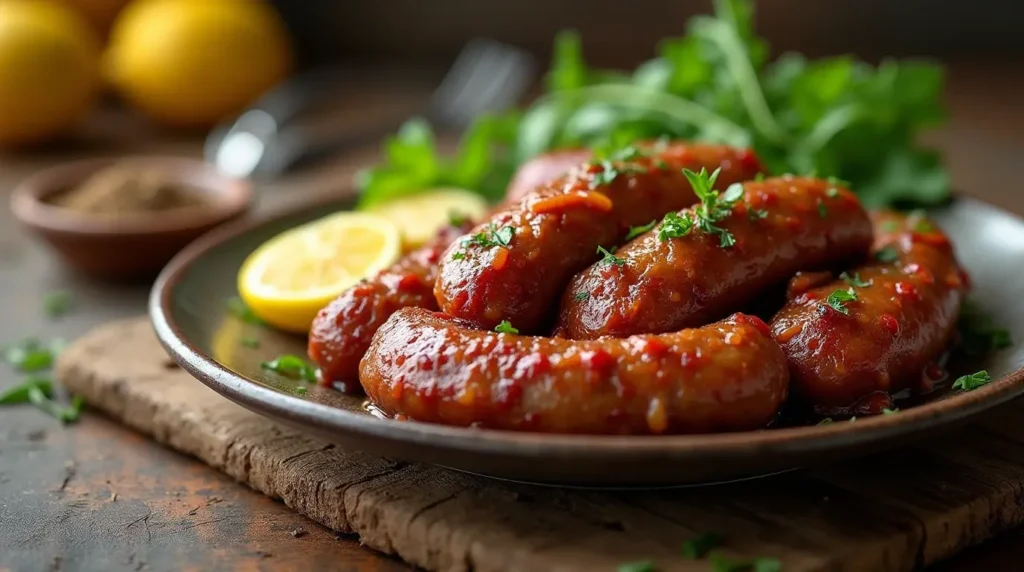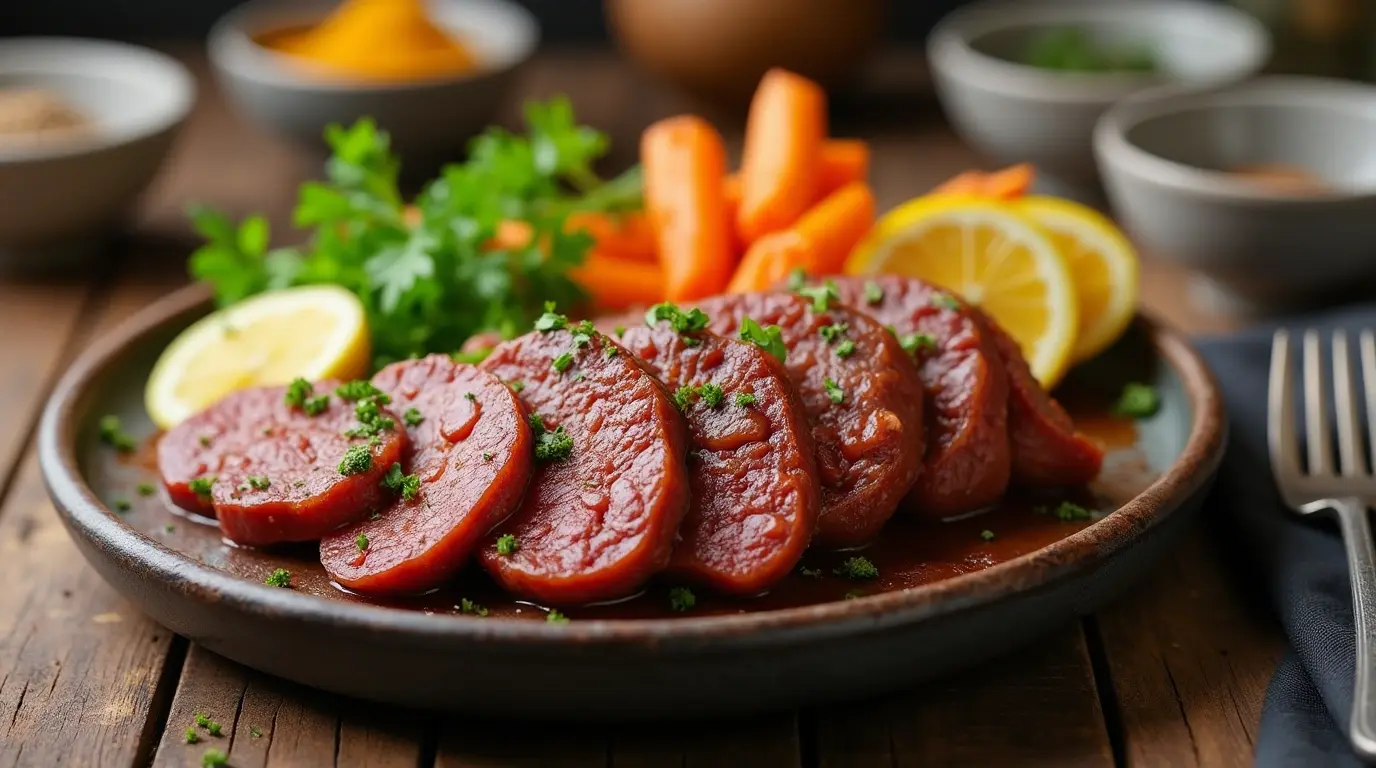There’s something comforting about the smell of homemade sausages sizzling in the pan, filling your kitchen with a sense of warmth and nostalgia. Whether you’re preparing a meal for a family gathering or just treating yourself to something hearty, making your own beef sausages brings satisfaction that store-bought simply can’t match. Today, we’re diving into the best beef sausage meat recipe—a guide that combines rich flavors with easy-to-follow steps to create homemade sausages from scratch. This beef sausage meat recipe will have your taste buds dancing and will soon be your go-to method for crafting delicious sausages.

Table of Contents
Why Choose Beef Sausage Meat?
The Benefits of Beef in Sausages
- Rich, Savory Flavor That Adds Depth
One of the reasons people choose beef for their beef sausage meat recipe is its rich, meaty flavor. This depth of flavor is what gives sausages a robust and hearty taste that’s perfect for a variety of dishes. Whether you’re grilling or pan-frying, beef in your beef sausage meat recipe always delivers a satisfying bite. Unlike lighter meats such as chicken or turkey, eef offers a deeper flavor profile, which is essential for creating sausages that are not only satisfying but also memorable. When preparing your beef sausage meat recipe, you’ll notice that the savory richness of the beef enhances the overall flavor of the sausages, making them stand out compared to lighter meats. Whether you’re grilling, frying, or roasting your sausages, beef holds up well to different cooking methods, infusing them with savory notes that resonate with each bite. - Higher Fat Content for Juicier Sausages
One of the reasons beef is often the meat of choice for sausages is its ideal fat-to-protein ratio, typically around 80/20 (80% lean meat and 20% fat). This higher fat content ensures that the sausages stay juicy and tender, preventing them from drying out during cooking. The fat also helps carry the flavors of your seasonings and spices throughout the sausage, creating a balanced and full-bodied taste. In contrast, leaner meats like chicken or turkey tend to produce drier sausages that lack the same level of richness. - Versatility: Beef Pairs Well with a Variety of Spices and Herbs
Beef sausages are incredibly versatile, making them an excellent base for countless flavor combinations. From smoky spices like paprika to zesty additions like chili flakes, beef is a meat that readily absorbs and enhances the spices you pair it with. You can experiment with herbs like thyme, rosemary, or sage for a more aromatic sausage or infuse it with garlicky undertones. The diversity of flavors that beef sausages can carry is one of the main reasons they’re so popular among home cooks and professional chefs alike.
Nutritional Profile of Beef Sausage Meat
- Higher Protein Content
Beef is an excellent source of protein, which is essential for muscle repair and overall body function. When compared to other meats like chicken, beef offers a higher protein content per serving, which can be especially beneficial if you’re looking to maintain or build muscle mass. A standard 3-ounce serving of cooked beef sausage can provide anywhere from 20-25 grams of protein, making it a filling and nutrient-dense option. - Fat Content: Balancing Flavor and Nutrition
The fat content in beef sausages, particularly when using an 80/20 lean-to-fat ratio, contributes to their juicy texture and rich flavor. While fat is often considered a less healthy macronutrient, the fat in beef sausages can be part of a balanced diet if consumed in moderation. It’s important to understand that fats are also necessary for the absorption of fat-soluble vitamins (A, D, E, K) and help to promote satiety. If you’re concerned about the fat content, you can adjust the ratio of lean to fatty cuts of beef to suit your nutritional needs. - Micronutrient Breakdown (Iron, Zinc, and More)
Beef sausages are also packed with vital micronutrients. Beef is one of the best natural sources of heme iron, which is crucial for red blood cell production and preventing anemia. It also provides zinc, which plays an important role in immune function and wound healing. Other beneficial nutrients include B vitamins (like B12 and niacin) that support energy metabolism and nerve function. Overall, beef sausages can be a great way to boost your intake of essential vitamins and minerals in a delicious and easy-to-prepare form.
Key Ingredients for the Best Beef Sausage Meat Recipe
Essential Ingredients
- Fresh Ground Beef (80/20 Lean-to-Fat Ratio)
The foundation of any great beef sausage is high-quality ground beef. Opt for an 80/20 lean-to-fat ratio, which strikes the perfect balance between tenderness and flavor. This blend ensures your sausages are juicy and flavorful without being greasy. - Pork Fat (Optional but Recommended)
While ground beef provides the base, adding pork fat enhances the flavor and texture of your sausages. The fat infuses the sausages with a richness that helps balance the beef’s flavor, making them more succulent. If you prefer a leaner sausage, you can reduce the amount of pork fat or skip it altogether, but for traditional sausage recipes, it’s a key ingredient. - Seasoning Basics: Salt, Pepper, Garlic Powder, and Onion Powder
Simple yet effective, seasoning your sausage mixture with salt, pepper, garlic powder, and onion powder creates a well-rounded flavor base. These ingredients add depth without overpowering the natural taste of the beef. Adjust the seasoning to taste, but keep in mind that a pinch of salt goes a long way in enhancing all the flavors. - Fresh Herbs (Parsley, Thyme, Sage)
Fresh herbs like parsley, thyme, and sage add aromatic notes that elevate the overall flavor of the sausages. These herbs complement the richness of beef, giving the sausages a fresh and earthy quality. You can also experiment with other herbs depending on your flavor preferences. - Liquid (Water or Beef Broth for Moisture)
Adding a liquid component is essential for achieving the right texture in your sausage mixture. Beef broth will infuse the sausages with additional savory flavor, while water will help keep the consistency smooth and easy to stuff. The amount of liquid you use will depend on the desired texture, but start with a little and gradually add more as needed. - Natural Sausage Casings (Optional but Recommended for a Classic Touch)
While casings are optional, they are a traditional and classic way to form sausages. Natural casings, typically made from hog or sheep intestines, provide a snap when you bite into the sausage and help contain the mixture during cooking. If you don’t want to use casings, you can form the sausages into patties or simply cook them loose, but the casing adds an authentic touch.
Flavor Variations You Can Experiment With
- Smoked Paprika, Chili Flakes, or Mustard Seeds
If you’re looking to add some spice or smokiness to your sausages, experiment with smoked paprika, chili flakes, or mustard seeds. Smoked paprika will give the sausages a warm, smoky flavor that pairs beautifully with the beef, while chili flakes provide a kick of heat. Mustard seeds offer a tangy bite that’s a little more subtle but adds complexity. - Sweet or Savory: Brown Sugar or Maple Syrup
If you prefer a slightly sweet sausage, adding brown sugar or a drizzle of maple syrup can balance the savory flavors. This creates a more nuanced flavor profile, making the sausages perfect for breakfast or a unique twist on a classic. The sweetness pairs especially well with spicy seasonings or tangy mustard. - Alcohol-Infused Options: Beer or Wine
For an added depth of flavor, try incorporating a splash of beer or wine into your sausage mixture. Beer will lend a malty richness, while wine can provide a hint of fruitiness or acidity, depending on the type you choose. Both ingredients can add an extra layer of sophistication to your sausages and pair well with various seasonings and herbs.
Table: Key Ingredients for Beef Sausage Meat Recipe
| Ingredient | Amount | Notes |
|---|---|---|
| Ground Beef | 1 lb | 80/20 lean-to-fat ratio preferred |
| Pork Fat | 1/4 lb | Optional, adds richness and flavor |
| Garlic Powder | 1 tsp | |
| Onion Powder | 1 tsp | |
| Fresh Parsley | 2 tbsp, chopped | Optional, for freshness |
| Beef Broth/Water | 1/4 cup | For moisture |
| Natural Casings | As needed | Available at butcher or online |

Step-by-Step Guide to Making Beef Sausage Meat
Step 1: Prepare the Meat
- Key Point: Use Freshly Ground Beef and Pork Fat (If Using)
Start with freshly ground beef for your beef sausage meat recipe, preferably from a trusted butcher or a reputable grocery store. The quality of the beef in your beef sausage meat recipe will make a noticeable difference in flavor and texture, so choose a cut with a good balance of lean meat and fat The fat content in the beef is essential to achieving juicy, flavorful sausages. If you’re using pork fat (which is common for beef sausages), ensure it’s finely ground and evenly distributed. The pork fat will not only add richness but also help bind the beef mixture together for a smooth texture. - Tip: Chill Your Equipment to Prevent the Fat from Warming Up and Turning Greasy
Temperature plays a crucial role in sausage-making. When fat becomes too warm, it can turn greasy, causing the sausages to lose their texture and become oily when cooked. To maintain the ideal texture, place your mixing bowl, utensils, and even the meat grinder or processor in the fridge for 30 minutes to chill. This simple step helps the fat stay firm and ensures your sausages turn out perfectly textured.
Step 2: Mixing the Ingredients
- Combine the Beef, Fat, and Dry Spices in a Large Bowl
In a large mixing bowl, combine your freshly ground beef with the pork fat (if using). Add your dry spices, such as garlic powder, onion powder, salt, pepper, and any other seasoning you’ve chosen. The key to flavorful sausages lies in even seasoning, so mix everything together thoroughly. The fat should be evenly distributed throughout the meat, giving the sausage a consistent flavor. - Gradually Add Liquid (Broth or Water) While Mixing
Slowly incorporate your liquid of choice—beef broth or water—into the mixture. It’s important to do this gradually, as adding too much liquid all at once can make the sausage mixture too wet. You want just enough liquid to help bind the meat together and keep it moist during cooking, but not so much that the sausages become soggy. The consistency should be firm but slightly sticky. As you mix, ensure all the spices and liquids are evenly absorbed into the meat mixture for the best flavor distribution.
Step 3: Stuffing the Sausages (Optional)
- Using Natural Casings: Soak the Casings and Rinse Thoroughly
If you’re using natural casings, begin by soaking them in warm water for 30 minutes to an hour to soften them. Once soaked, rinse the casings thoroughly inside and out to remove any salt used in preservation. Make sure the casings are free of any debris, as this could affect the taste and texture of your sausages. It’s important to check for holes in the casings before stuffing, as any tears could result in leaking during cooking. - Stuff the Mixture into Casings Tightly but Not Too Tightly
Using your hands or a sausage stuffer, stuff the sausage mixture into the casings, being careful not to overstuff them. Overstuffing can cause the casings to burst while cooking, ruining the sausages. As you stuff, try to keep the sausages tightly packed to avoid air pockets, but leave enough room for them to expand slightly during cooking. - Without Casings: Form into Patties or Links Using Your Hands
If you prefer not to use casings, simply take the sausage mixture and shape it into patties or small links with your hands. Make sure they are uniform in size so they cook evenly. If you’re making links, twist them at even intervals to create the sausage links. While the texture won’t be the same as sausages in casings, patties and links still make for delicious alternatives. - Tip: Use a Sausage Stuffer for Best Results
If you want a professional-level result and find stuffing sausages by hand challenging, invest in a sausage stuffer. These devices make the process smoother, allowing for uniform stuffing and reducing the risk of overstuffing or tearing the casings.
Step 4: Cooking the Sausages
- Pan-Fry Method: Cook on Medium Heat for 10-12 Minutes
If you prefer the classic pan-fried approach, heat a little oil in a skillet over medium heat. Place the sausages in the pan, making sure not to overcrowd them. Cook for 10-12 minutes, turning frequently to ensure even browning on all sides. Check the internal temperature with a meat thermometer—it should reach 160°F to ensure the sausages are fully cooked through. - Grill Method: Grill for 12-15 Minutes, Turning Often
For a smoky, charred finish, grilling is a great method. Preheat your grill to medium heat, and place the sausages on the grill, turning them often to avoid burning. Grill for 12-15 minutes, or until they are cooked through and have a golden-brown crust. Be sure to check the internal temperature to confirm they’ve reached the recommended 160°F. - Oven-Baked Method: Preheat Oven to 375°F and Bake for 20-25 Minutes
If you prefer a hands-off method, baking your sausages in the oven is an easy option. Preheat your oven to 375°F (190°C) and place the sausages on a baking sheet lined with parchment paper or a silicone mat. Bake for 20-25 minutes, flipping halfway through for an even golden-brown color. Again, check the internal temperature with a meat thermometer to ensure they’re cooked to perfection. - Note: Always Check the Internal Temperature Using a Meat Thermometer
Regardless of the cooking method, always use a meat thermometer to ensure the sausages have reached a safe internal temperature of 160°F. This not only ensures food safety but also prevents undercooking, which could affect both the texture and flavor of your sausages.

Tips for Perfect Beef Sausages Every Time
Avoid Overmixing
When mixing your sausage ingredients, it’s important not to overdo it. Overmixing can break down the fat too much, causing the sausages to become dense and tough. Mix just enough to incorporate all the ingredients into a uniform mixture—about 3-5 minutes of gentle mixing should do the trick. The goal is to keep the fat intact so it stays evenly distributed and helps retain moisture during cooking.
Season to Taste
Before you stuff your sausages into casings or form patties, be sure to taste your mixture. Take a small portion of the raw mixture, fry it in a pan for a minute or two, and taste it to check the seasoning. This allows you to adjust the flavors before committing to the final product. If you feel it needs more salt, garlic, or other spices, you can add them at this stage.
Storage Tips for Beef Sausages
- Refrigerating Uncooked Sausages
If you don’t plan to cook your sausages immediately, you can store the uncooked sausages in the refrigerator for up to 2 days. Make sure to wrap them tightly in plastic wrap or place them in an airtight container to prevent drying out. For optimal freshness, cook them within this time frame. - Freezing Sausages for Longer Storage
To store your sausages for a longer period, freezing is the best option. Wrap each sausage individually in plastic wrap or place them in a freezer-safe bag. If you’re making a large batch, you can stack them between layers of parchment paper to avoid them sticking together. When you’re ready to cook, simply thaw them in the refrigerator overnight and cook as usual. Homemade sausages can be frozen for up to 3 months for the best flavor and texture.
These detailed steps and tips will guide you through the process of making the best beef sausage meat, ensuring delicious, flavorful sausages every time. Whether you’re using casings or not, and regardless of the cooking method, the key is consistency and attention to detail in each step.
FAQs About Beef Sausage Meat Recipe
- How Do I Make Beef Sausages Without Casings?
- Simply shape the sausage mixture into patties or links using your hands. If you’re looking for a casing-like appearance, you can wrap them in foil before cooking.
- Can I Use Ground Beef Alone for Sausages?
- You can, but the addition of fat (either pork fat or beef fat) ensures the sausages remain moist and flavorful. Beef alone can lead to dry sausages.
- What Can I Substitute for Natural Sausage Casings?
- If you don’t have natural casings, you can make sausage patties, or use synthetic casings, which are available in most specialty food stores.
- Can I Use Leaner Meat for Beef Sausages?
- While you can use leaner meat like 90/10 ground beef, the sausages may be less juicy. It’s best to stick with 80/20 beef for optimal flavor and moisture.
Conclusion: Make Your Best Beef Sausage Meat Recipe Today!
Now that you have the perfect beef sausage meat recipe in hand, it’s time to roll up your sleeves and start cooking. Whether you’re new to making sausages or a seasoned pro, this recipe offers simplicity without compromising on flavor. Now that you’ve mastered the beef sausage meat recipe, it’s time to enjoy your homemade sausages! Whether you serve them with your favorite veggies, on a bun with all the fixings, or just on their own, these sausages will surely be a hit. The richness and flavor from your beef sausage meat recipe will leave everyone asking for more! Remember, the key to great sausage is quality ingredients, proper seasoning, and a little patience. Happy cooking!


1 thought on “The Best Beef Sausage Meat Recipe for Tender”